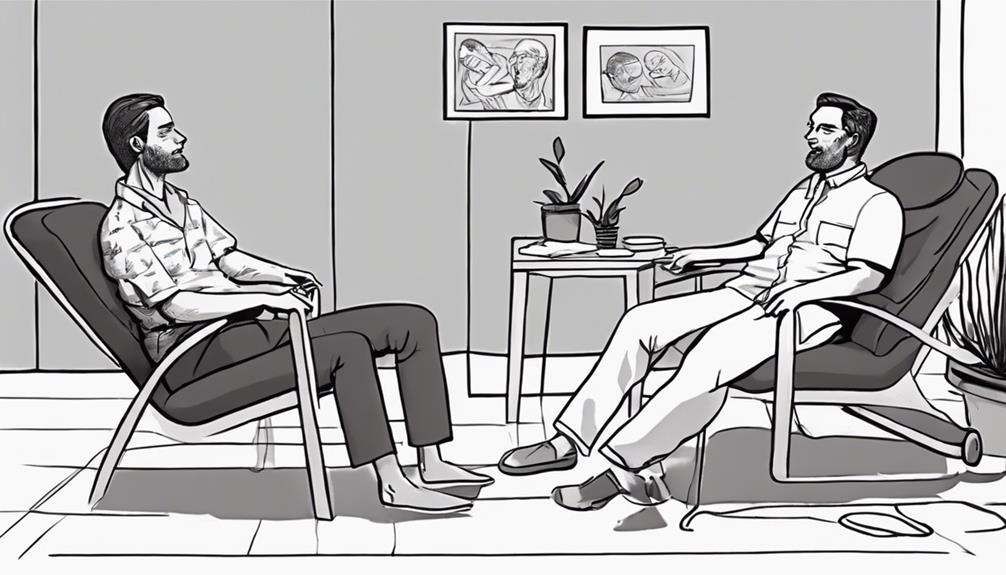In a somatic therapy session, you experience a holistic approach integrating mind and body to address emotional issues and trauma effectively. Therapists help you tune into physical sensations and movements, guiding you to process deep-seated emotions. Techniques like breathing exercises play an essential role in these sessions, fostering self-awareness and emotional regulation. Through body awareness exercises and grounding practices, you access calming resources to safely process stored emotions. If you're intrigued by how somatic therapy can aid in mindfulness and gentle movements to connect your body and mind, there's more valuable insight waiting.
Key Takeaways
- Somatic therapy involves recognizing physical sensations and movements.
- Therapists aid in releasing tension and fostering self-awareness.
- Techniques like breathwork and body awareness are central.
- Sessions focus on the mind-body connection and emotional healing.
- The process includes movement therapy and grounding practices.
Understanding Somatic Therapy

Exploring the mind-body connection to address emotional issues and trauma is the essence of understanding somatic therapy.
In somatic therapy, the focus lies on recognizing physical sensations, movements, and body awareness to process deep-seated emotions. Through this approach, therapists assist individuals in releasing tension, regulating emotions, and fostering self-awareness.
Techniques such as breathing exercises play a pivotal role in somatic therapy sessions, aiding in mindfulness and gentle movements to connect the body and mind.
Somatic Therapy Techniques

You'll explore key somatic therapy techniques that include body awareness exercises and grounding practices. These techniques are practical tools to help you access calming resources and process stored emotions in a safe way.
Movement therapy, breathwork, and mindfulness practices are commonly utilized in somatic sessions to support your healing journey.
Key Somatic Techniques
Key somatic techniques, such as breathwork, movement therapy, touch, and mindfulness practices, are integral components of somatic therapy sessions.
Somatic therapists often include body awareness exercises to help clients identify tension spots and encourage relaxation. Techniques like grounding, pendulation, and resourcing are utilized to assist individuals in navigating traumatic emotions and accessing calming resources within themselves.
Additionally, somatic therapists may incorporate acupressure, dance, and other mind-body techniques to facilitate the release of pent-up emotions and support the healing process. These approaches focus on engaging the body in the therapeutic journey, addressing both the physical and emotional aspects of well-being.
Practical Application Examples
To apply key somatic techniques effectively, practitioners in somatic therapy sessions often guide clients through breathwork, movement therapy, and mindfulness practices. Body awareness exercises are utilized to help clients identify tension spots and promote healing within their bodies.
During sessions, techniques like pendulation are employed to assist clients in maneuvering through traumatic emotions in a safe and controlled manner. Additionally, resourcing is used to help individuals recall calming resources from their lives to support emotional regulation throughout the session.
Somatic therapy sessions may also incorporate touch, acupressure, and dance as tools to facilitate emotional release and healing. These practical applications offer clients a holistic approach to healing by integrating various techniques that address both the mind and body, promoting overall well-being and emotional balance.
Through the utilization of these diverse somatic therapy techniques, clients can explore and address their emotional experiences in a profound and transformative way.
Trauma Therapy & Release

When it comes to trauma therapy in somatic sessions, you'll focus on releasing trapped emotions stored in your body from past traumatic experiences.
Through mind-body techniques like movement, you'll be able to process and release trauma, leading to positive outcomes by integrating physical and emotional healing.
Acknowledging and working through the physical manifestations of past traumas is key to the process of trauma release in somatic therapy.
Trauma Stored in Body
Storing trauma in your body's tissues and nervous system can have a significant effect on both your emotional and physical well-being. Traumatic experiences can linger in your body's somatic memory, showing up as chronic pain, anxiety, or hypervigilance.
Somatic therapy explores the connection between your body and emotions, aiming to process and release these stored traumas. Using somatic therapy techniques, practitioners help you address the trauma held within your body, facilitating both physical and emotional release.
By participating in somatic therapy sessions, you can start to untangle and heal deep-seated emotional wounds that may be impacting your overall well-being. This approach provides a comprehensive way to address past traumas, enabling you to work through the effects they've left on your body and mind.
Give yourself the opportunity to explore the profound impact that stored trauma can have on your life and set out on a journey towards healing through somatic therapy.
Releasing Trapped Emotions
Releasing trapped emotions through somatic therapy sessions involves utilizing various techniques to facilitate the physical release and processing of unresolved emotions stored in your body. Somatic techniques target somatic memory, where past trauma is held in the body and can manifest as physical discomfort.
During these sessions, techniques like movement, touch, and breathwork are used to help you release trapped emotions. As you engage in breathwork and movement, you may feel these emotions surfacing and being discharged from your body. This process is essential for emotional regulation and healing from past trauma.
Positive Outcomes of Release
Positive outcomes emerge from the release of trapped emotions through somatic therapy, contributing to a healthier emotional state and enhanced well-being. By addressing past trauma and draining emotions of their power, individuals can experience increased emotional resilience and develop better coping skills.
This newfound emotional strength not only helps in managing stress but also leads to an overall improvement in well-being. Additionally, the process of releasing trauma through somatic therapy can provide relief from chronic pain, alleviate muscle tension in areas like the neck, shoulders, jaw, and back, and help individuals overcome disrupted sleep patterns.
As a result, individuals often report reduced anxiety, improved mood, and enhanced self-awareness. Engaging in somatic work allows individuals to move forward from their past experiences, enabling them to lead a more balanced and fulfilling life.
Legitimacy & Comparison

The legitimacy of somatic therapy as a recognized form of treatment is evident, albeit with a smaller evidence base compared to cognitive behavioral therapy (CBT).
Despite its efficacy in addressing emotional health, somatic therapy still faces challenges:
- Insurance coverage for somatic therapies, particularly touch-based interventions, may be limited due to skepticism or lack of understanding by insurance companies.
- Risks associated with somatic therapy sessions include the potential for misinterpretation of touch, re-traumatization, or inappropriate regression if not conducted with proper training and supervision.
- Training standards and supervision in somatic therapy have been continuously improved to address concerns about touch misinterpretation, re-traumatization, and inappropriate regression.
- Inappropriate regression in somatic therapy can lead to a client developing an infantile dependency, emphasizing the importance of therapists being cautious and skilled in their approach.
Somatic Therapy Benefits

As you explore the benefits of somatic therapy, you'll uncover its profound impact on emotional well-being and physical health.
Somatic therapy offers a range of advantages, including the ability to relieve stress, address physical discomfort, and enhance emotional resilience. By draining emotions of their power, this therapy can provide relief from chronic pain and anxiety disorders, promoting overall well-being.
Somatic therapy targets muscle tension in areas like the neck, shoulders, jaw, and back, offering a unique approach to healing trauma and conditions such as PTSD. It goes beyond traditional talk therapy by engaging the body in the healing process, leading to improved self-awareness and trust in oneself.
Additionally, somatic therapy supports individuals dealing with depression and chronic pain, offering a holistic approach to addressing both physical symptoms and emotional struggles.
Embrace the benefits of somatic therapy to experience a profound shift towards healing and self-discovery.
Somatic Therapy in Healing

Discover how somatic therapy plays a crucial role in facilitating healing by addressing the mind-body connection and releasing stored emotional trauma through specialized techniques.
Somatic therapy in healing focuses on revealing traumatic memories stored at a cellular level, aiding in the release of stress and promoting both physical and mental well-being.
Through somatic interventions, individuals can tackle a wide range of health issues by delving into the body's wisdom and utilizing expressive arts to process emotions.
This therapeutic approach emphasizes grounding techniques and mindfulness practices to help individuals connect with their bodies, fostering a deeper understanding of self and promoting overall healing.
Somatic Psychotherapy Overview

Delving into the world of somatic psychotherapy reveals a profound exploration of how past experiences intricately intertwine with the body on a cellular level.
Somatic psychotherapy, a therapy modality, acknowledges that memories and emotions aren't only stored in the mind but also within the body.
This interconnectedness of mind and body is a core principle in somatic psychotherapy, emphasizing the importance of integrating body awareness into the therapeutic process.
Benefits of Somatic Interventions

Discover the potential for healing and growth through the powerful benefits of somatic interventions. Somatic therapy offers various benefits that can aid in your journey towards wellness and self-discovery.
Here are some key advantages of engaging in somatic interventions:
- Relief for Trauma Survivors: Somatic interventions provide effective relief from trauma symptoms and support individuals in building security and trust.
- Stress Relief: Particularly beneficial for individuals dealing with stressors, somatic therapy offers a path towards long-term stress relief.
- Healing on a Cellular Level: By addressing deep-seated beliefs stored in the body, somatic interventions facilitate healing on a profound cellular level.
- Release of Trapped Emotions: Through the process of releasing trapped emotions and promoting healing via the body's organic processes, somatic therapy sessions help individuals confront and overcome hidden beliefs.
Embark on a somatic therapy journey to experience these transformative benefits firsthand.
Accessing Root Issues

To access root issues effectively, somatic therapy sessions explore into body-based beliefs and emotions stored on a profound cellular level. By delving into these deep-seated aspects, individuals can uncover hidden beliefs that might be contributing to emotional distress and physical tension.
Somatic therapy provides a unique opportunity to address trapped emotions that reside within the body, allowing for their release and subsequent healing.
Through somatic therapy sessions, individuals can confront and overcome these entrenched beliefs, leading to a more holistic sense of well-being. Unlike other forms of therapy that may focus solely on talking or skills, somatic therapy offers a direct pathway to accessing and addressing root issues by working through the body.
Frequently Asked Questions
What Happens in a Somatic Session?
During a somatic session, you'll explore physical sensations, emotions, and movements. Therapists help you notice how your body responds to stress. Through exercises like breathing techniques and mindful movement, you'll release tension and integrate emotional experiences for healing.
What Is the Somatic Experiencing Therapy Process?
To understand the somatic experiencing therapy process, you'll explore bodily sensations linked to trauma memories. By safely acknowledging these sensations, your nervous system gradually discharges trapped fight-or-flight energy, facilitating healing at a physiological level.
What Is an Example of a Somatic Therapy Session?
You think a somatic therapy session involves just talking, but surprise! You'll actually be encouraged to move, breathe, and feel. The therapist guides you to explore emotions through your body for healing.
What Is an SE Session Like?
In an SE session, you'll focus on bodily sensations, exploring emotions with guidance. Techniques like grounding help manage intense feelings. Therapists support your body awareness and self-regulation skills to process stored trauma gently.
Conclusion
So, now you know all about what happens in a somatic therapy session! It's a powerful process that helps you connect with your body and emotions in a safe and supportive environment.
By addressing trauma and releasing stored tension, somatic therapy can bring about deep healing and transformation.
Give it a try and see how it can help you on your journey towards emotional well-being.










